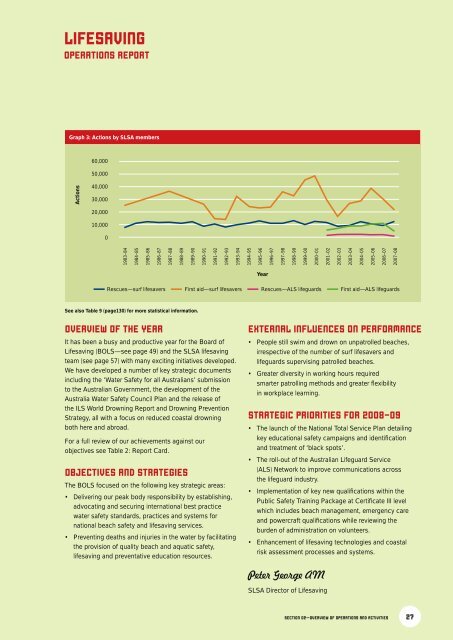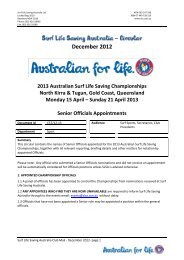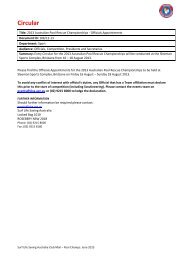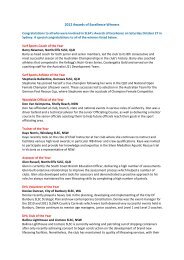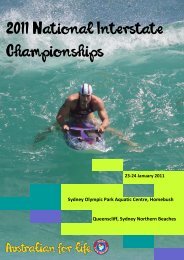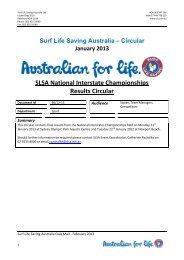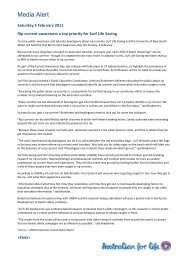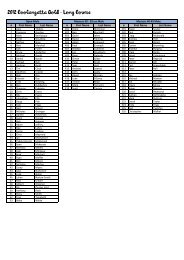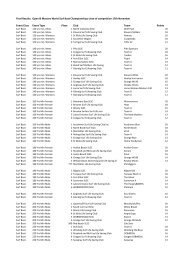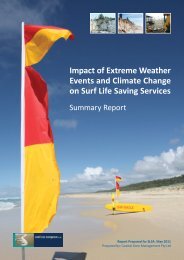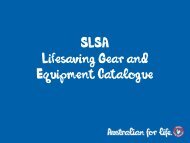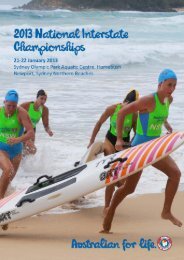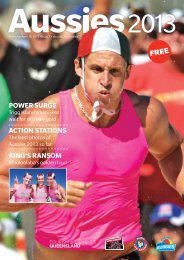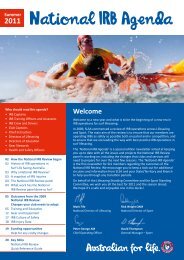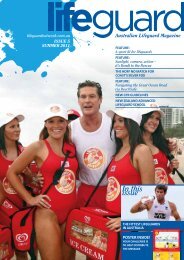SURF LIFE SAVING AUSTRALIA ANNUAL REPORT 2007–08
SURF LIFE SAVING AUSTRALIA ANNUAL REPORT 2007–08
SURF LIFE SAVING AUSTRALIA ANNUAL REPORT 2007–08
- TAGS
- surf
- australia
- annual
- sls.com.au
Create successful ePaper yourself
Turn your PDF publications into a flip-book with our unique Google optimized e-Paper software.
<strong>LIFE</strong><strong>SAVING</strong><br />
OPERATIONS <strong>REPORT</strong><br />
Graph 3: Actions by SLSA members<br />
Actions<br />
60,000<br />
50,000<br />
40,000<br />
30,000<br />
20,000<br />
10,000<br />
0<br />
1983–84<br />
See also Table 9 (page130) for more statistical information.<br />
1984–85<br />
OVERVIEW OF THE YEAR<br />
It has been a busy and productive year for the Board of<br />
Lifesaving (BOLS—see page 49) and the SLSA lifesaving<br />
team (see page 57) with many exciting initiatives developed.<br />
We have developed a number of key strategic documents<br />
including the ‘Water Safety for all Australians’ submission<br />
to the Australian Government, the development of the<br />
Australia Water Safety Council Plan and the release of<br />
the ILS World Drowning Report and Drowning Prevention<br />
Strategy, all with a focus on reduced coastal drowning<br />
both here and abroad.<br />
For a full review of our achievements against our<br />
objectives see Table 2: Report Card.<br />
1985–86<br />
OBJECTIVES AND STRATEGIES<br />
The BOLS focused on the following key strategic areas:<br />
• Delivering our peak body responsibility by establishing,<br />
advocating and securing international best practice<br />
water safety standards, practices and systems for<br />
national beach safety and lifesaving services.<br />
• Preventing deaths and injuries in the water by facilitating<br />
the provision of quality beach and aquatic safety,<br />
lifesaving and preventative education resources.<br />
1986–87<br />
1987–88<br />
1988–89<br />
1989–90<br />
1990–91<br />
1991–92<br />
1992–93<br />
1993–94<br />
1994–95<br />
Rescues—surf lifesavers First aid—surf lifesavers Rescues—ALS lifeguards First aid—ALS lifeguards<br />
1995–96<br />
Year<br />
1996–97<br />
1997–98<br />
1998–99<br />
1999–00<br />
2000–01<br />
EXTERNAL INFLUENCES ON PERFORMANCE<br />
• People still swim and drown on unpatrolled beaches,<br />
irrespective of the number of surf lifesavers and<br />
lifeguards supervising patrolled beaches.<br />
• Greater diversity in working hours required<br />
smarter patrolling methods and greater fl exibility<br />
in workplace learning.<br />
STRATEGIC PRIORITIES FOR 2008–09<br />
• The launch of the National Total Service Plan detailing<br />
key educational safety campaigns and identifi cation<br />
and treatment of ‘black spots’.<br />
• The roll-out of the Australian Lifeguard Service<br />
(ALS) Network to improve communications across<br />
the lifeguard industry.<br />
• Implementation of key new qualifi cations within the<br />
Public Safety Training Package at Certifi cate III level<br />
which includes beach management, emergency care<br />
and powercraft qualifi cations while reviewing the<br />
burden of administration on volunteers.<br />
• Enhancement of lifesaving technologies and coastal<br />
risk assessment processes and systems.<br />
Peter George AM<br />
SLSA Director of Lifesaving<br />
2001–02<br />
2002–03<br />
2003–04<br />
2004–05<br />
2005–06<br />
2006–07<br />
SECTION 02—OVERVIEW OF OPERATIONS AND ACTIVITIES<br />
<strong>2007–08</strong><br />
27


